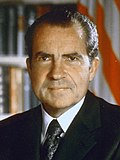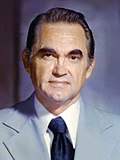| |||||||||||||||||||||||||||||||||
| |||||||||||||||||||||||||||||||||
| |||||||||||||||||||||||||||||||||
| |||||||||||||||||||||||||||||||||
| Elections in Wisconsin |
|---|
 |
The 1968 United States presidential election in Wisconsin was held on November 5, 1968, as part of the 1968 United States presidential election. State voters chose 12 electors to the Electoral College, who voted for president and vice president.
The 1958 midterm elections saw a major change in Wisconsin politics, as Gaylord A. Nelson became only the state's second Democratic Governor since 1895, and the state also elected Democrats to the position of treasurer and Senator, besides that party gaining a majority in the State Assembly for only the second time since the middle 1890s. They maintained a close balance in the early 1960s, signaling the state's transition to a swing state. The predicted racial backlash from urban Polish-Americans, seen in the 1964 primaries when George Wallace received over 30 percent of Wisconsin's vote,[1] did not affect Lyndon B. Johnson’s big victory in the state in 1964, but would have severe effects when racial unrest began in 1966.
Anti-war Minnesota Senator Eugene McCarthy would easily win Wisconsin’s 1968 Democratic presidential primary against incumbent President Johnson, who soon announced he would not run for re-election in 1968.[2] Former Vice-President and 1960 Republican nominee Richard Nixon won eighty percent of the vote in the state’s Republican primary.[2]
At the beginning of the campaign, the deep divisions within the Democratic Party were worrisome for political scientists and for the party itself.[3] The first poll said that Nixon was certain to carry Wisconsin,[4] and this opinion was repeated early in October.[5]
Hopes remained dim as the election neared despite the belief by local Representative Clement J. Zablocki that the independent candidacy of George Wallace was losing its impact in the racial-unrest-stricken southern urban counties around Milwaukee, Racine and Kenosha,[6] where Wallace had campaigned extensively in September in his effort to put the election into the House of Representatives.[7] Although the gap would narrow in the last polls,[8] Wisconsin would be carried by Nixon with 47.89 percent of the vote, over Humphrey with 44.27 percent and Wallace with 7.56 percent. Wallace fared best in rural northern areas away from Lake Superior and in southern suburbs affected by racial conflict.
Wisconsin weighed in for this election as 2.92% more Republican than the nation at large. This was the last election until 1996 that Wisconsin was the most Republican of the three Rust Belt swing states (also consisting of Michigan and Pennsylvania). Wisconsin would vote more Democratic than both Michigan and Pennsylvania in all but one election from 1972 to 1988.
Cite error: There are <ref group=lower-alpha> tags or {{efn}} templates on this page, but the references will not show without a {{reflist|group=lower-alpha}} template or {{notelist}} template (see the help page).
- ^ Phillips; The Emerging Republican Majority, p. 396
- ^ a b Kenworthy, E.W.; ‘M‘Carthy Wins Wisconsin: Polls 57% to Johnson’s 35; G.O.P. Gives 80% to Nixon: Reagan Gets 10% Kennedy Write-in 6%’; Special to The New York Times ; April 3, 1968, p. 1
- ^ Otten, Allen L.; ‘A Party Divided: Democrats’ Rifts Pose Problems for Candidates As Campaign Develops’; The Wall Street Journal, August 29, 1968, p. 1
- ^ Broder, David; ‘Nixon, Wallace have 22 states all sewed up’, The Boston Globe, September 11, 1968, p. 15
- ^ ‘Electoral Vote: Nixon 359, HHH 46’; The Boston Globe, October 7, 1968, p. 24
- ^ Lyons, Richard L.; ‘Wisconsin’s Nelson Likely to Buck GOP Tide: Campaign '68 House Fight Sees Wallace Decline Knowles Popular’; The Washington Post and Times-Herald, October 29, 1968, p. A4
- ^ Evans, Rowland and Novak, Robert; ‘Growing Wallace Strength Poses a Threat to Nixon in Key States’; The Washington Post, September 20, 1968, p. A25
- ^ ‘A Final State-by-State Political Survey...: ...A Last Reading on the Campaign of 1968’; The Washington Post and Times-Herald, November 3, 1968, p. B4




